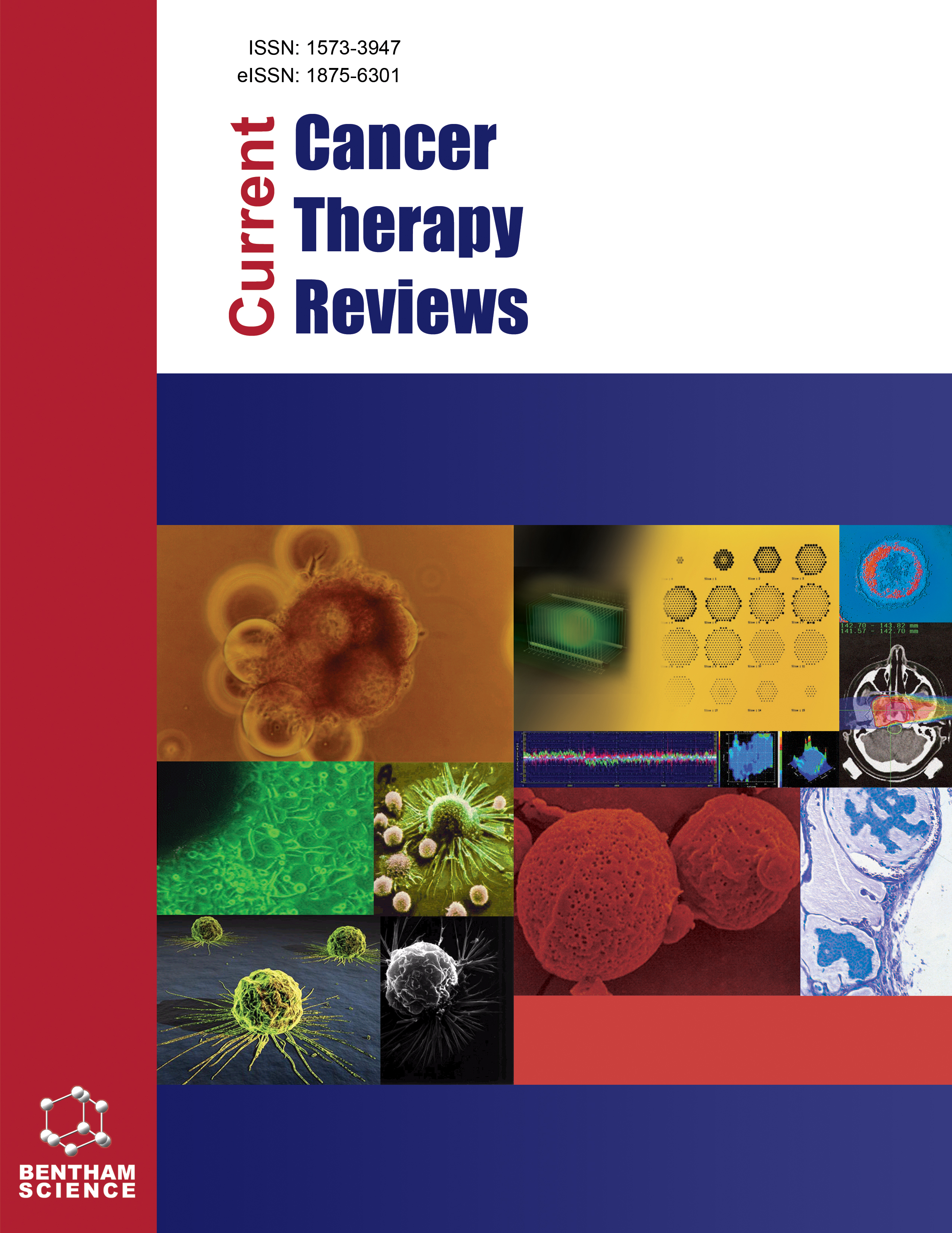- Home
- A-Z Publications
- Current Cancer Therapy Reviews
- Previous Issues
- Volume 3, Issue 1, 2007
Current Cancer Therapy Reviews - Volume 3, Issue 1, 2007
Volume 3, Issue 1, 2007
-
-
Transcription Factors as Targets for Cancer Therapy: AP-1 a Potential Therapeutic Target
More LessAuthors: Virna D. Leaner, Howard Donninger and Michael J. BirrerThe field of cancer therapy is rapidly moving forward with the development of numerous prospective new agents designed to inhibit cellular factors involved in signal transduction, cell proliferation, and the onset of apoptosis. At the core of these biological processes are transcription factors that are the functional mediators of these effects. Transcription factors are the downstream targets of numerous signal transduction pathwa Read More
-
-
-
Cellular Senescence as a Target in Cancer Control
More LessSomatic cells show a spontaneous decline in growth rate in continuous culture. This is not related to elapsed time but to an increasing number of population doublings, eventually terminating in a quiescent but viable state, termed replicative senescence. These cells are commonly multinucleated and do not respond to mitogens or apoptotic stimuli. Cells displaying characteristics of senescent cells can also be obser Read More
-
-
-
The HOX Gene Network as a Potential Target for Cancer Therapy
More LessAuthors: Monica Cantile, Giulia Schiavo, Luigi Terracciano and Clemente CilloAlthough Hox genes have been identified as master regulatory genes controlling embryonic development, an alternative view on the role of the Hox gene network suggests that it regulates crucial processes at cellular level in eukaryotic organisms. The Hox network acts at the nuclear cell level as a decoding system for external inductive signals to activate specific genetic programs. Cancer can be considered as an anomal Read More
-
-
-
Molecular and Genetic Profiling of Prostate Cancer: Implications for Future Therapy
More LessAuthors: Gregory Saia, Min Zhang, Vincent Depalo, Tim Lautenschlager and Arnab ChakravartiProstate cancer is predicted to be the most common cancer diagnosed in American men in 2006 with an estimated 230,000 new cases in the United States alone [1]. It is likely to result in over 27,000 deaths in 2006, and the average male will have a one in six chance of developing this malady in his lifetime [1]. These statistics illustrate the need to have screening and treatment systems in place that possess both a high Read More
-
-
-
Haploidentical Stem Cell Transplantation in Childhood
More LessAuthors: Peter Bader, Andre Willasch, Dietrich Niethammer and Thomas KlingebielAllogeneic stem cell transplantation has become an important treatment option for many children with malignant and non malignant diseases during the past decades. However, this therapy was for a long time restricted to patients having an “HLA identical donor”. In most recent years donor registries all over the world have extended and the numbers of registered volunteers have substantially increased during the last Read More
-
-
-
A Review of the Use of Stents for Palliation of Esophageal and Lung Cancer
More LessAuthors: Costas S. Bizekis, Harvey I. Pass and Michael D. ZervosAccording to the American Cancer Society, there will be an estimated 14,520 new cases of esophageal cancer and 174,470 new cases of lung cancer in 2005 [1]. Close to 60% of these patients with esophageal cancer will present at an advanced stage not amenable to cure, but still will require palliation of their dysphagia [2]. Conventional plastic stents (CPS) were used initially, and with continuous improvement in techno Read More
-
-
-
The Role of Antioxidant Enzymes in the Growth of Pancreatic Carcinoma
More LessAuthors: Nazee Jabbari and Joseph J. CullenAdenocarcinoma of the pancreas is the fourth leading cause of cancer death in the United States. Because of the poor therapeutic responsiveness of pancreatic cancer to surgery, chemotherapy, and radiation therapy, survival beyond five years is rare with median survival less than six months. K-ras mutations have been identified in up to 95% of pancreatic cancers, implying their critical role in the molecular pathogenesis. Ras o Read More
-
-
-
Aromatase Inhibitors for Treatment of Breast Cancer
More LessAuthors: John R. Benson and Oduru RavisekarBreast cancer remains the commonest malignancy amongst women and its incidence continues to increase worldwide. This inexorable rise in numbers of women suffering from the disease is particularly notable in those countries which previously had a relatively low incidence of breast cancer but have now adopted Western lifestyles with changes in reproductive behaviour and greater usage of the oral contraceptive pill. Read More
-
Volumes & issues
-
Volume 21 (2025)
-
Volume 20 (2024)
-
Volume 19 (2023)
-
Volume 18 (2022)
-
Volume 17 (2021)
-
Volume 16 (2020)
-
Volume 15 (2019)
-
Volume 14 (2018)
-
Volume 13 (2017)
-
Volume 12 (2016)
-
Volume 11 (2015)
-
Volume 10 (2014)
-
Volume 9 (2013)
-
Volume 8 (2012)
-
Volume 7 (2011)
-
Volume 6 (2010)
-
Volume 5 (2009)
-
Volume 4 (2008)
-
Volume 3 (2007)
-
Volume 2 (2006)
-
Volume 1 (2005)
Most Read This Month
Article
content/journals/cctr
Journal
10
5
false
en


